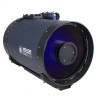Meade 14 inch Instruction Manual - Page 65
Observing Considerations
 |
View all Meade 14 inch manuals
Add to My Manuals
Save this manual to your list of manuals |
Page 65 highlights
Fig. 52: Position the holes over the shoulder bolts. When they are in place, slide the OTA back so that the shoulder bolts lock into the slots. c. Lock the OTA in place using the four 3/8"-16x3/4" bolts. Thread up the four bolts into the bottom of the Dec. castings, two on each side. Using the supplied hex key, tighten to a firm feel only (Fig. 53). Attaching the Power and Data Cords Several power and data cords are supplied with the 16" LX200GPS. These should all be attached before powering up the telescope. a. Confirm that the power switch (A, Fig. 43) on the power panel is in the OFF position. Connect the power adapter to the 18vDC connector (B, Fig. 43). b. 2 short cords (8" long) with DB-9 connectors are supplied to provide power to the Dec. system, the GPS, and the level sensor. Plug into the two DB-9 connectors located at the top of the sides of the fork and the Dec. casting (Fig. 54). c. Connect the Autostar II handbox to the HBX connector (F, Fig. 43) on the control panel. d. Connect the supplied coil cord from the fan to the 12vDC output jack (E, Fig. 43) on the control panel. Fig. 53: Tighten the fork arm assembly using the provided hex key. Fig. 54: Plug in the DB-9 connectors to provide power from the Dec. motor to the fork arms. LX200GPS TIPS Observing Considerations • Try to pick an observing site away from street and house lights and car headlights. While this is not always possible, the darker the site, the better. • Give your eyes about ten minutes to adjust to the darkness before observing. Give your eyes a rest from observing every ten or fifteen minutes to relieve eyestrain. • Try not to use a standard flashlight. Experienced observers use red LED flashlights, the red utility light on the Autostar II handbox, or tape red cellophane over their flashlights to use for setup and map reading so they don't have to continually readjust their eyes to the darkness. Be careful not to shine bright lights if there are other observers in the area. Do not shine a flashlight into the telescope while someone is observing! • Dress warmly. It gets chilly when you're sitting for prolonged periods. • Practice setting up your equipment during the day or in a lighted area to become familiar with it before going to a dark site. • Use your 26mm eyepiece to view terrestrial objects and wider areas of space, such as open star clusters. Use optional higher power eyepieces, such as a 9mm eyepiece (see OPTIONAL ACCESSORIES, page 41 for more details), when you wish to view something up close, such as craters on the Moon or the rings of Saturn. 65















